DAM, HEDDON, CREEK CHUB, GOBEL & EVER READY.
About seven years ago when I did my first tackle show in Germany I was introduced to the DAM Vampir lure and straight away I thought that it was a copy of the Heddon Gamefisher.
I did wonder why Heddon never took legal action against DAM and I thought what if Heddon made the bait for DAM? (Or visa versa.) After all the Gamefisher had been introduced in 1923 and had US Patent No. 1,477,756 filed in August 1922 covering its design.
Over the years I have had many conversations with collectors in Germany and America and the conclusion is that no one knows who made them.
My own opinion is that Heddon allowed DAM to produce them. The argument that they were all made by the same company falls down because the German baits have the slotted “V” body whereas the American baits have the inverse “V” body.
The illustration right is from the 1936 DAM catalogue and the baits are divided into two types. Those on the left are wobblers with a flatter body and those on the right are wobblers with a rounder body. It is the baits on the right that will be concentrating on in this article.
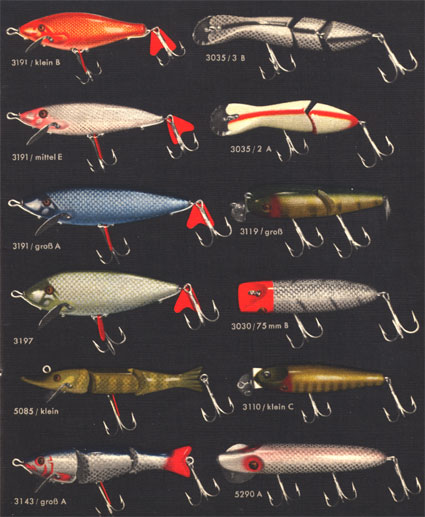


Above left Illustration from the 1938 DAM catalogue.
Top right Heddon Gamefisher. Bottom right Bass Wobbler 3119 showing the slotted “V” body.
Through the years I have continued to look at the illustration of the lures in 1936, but it was not until that I took a closer look at the rounded wobblers that I noticed even more similarities to American-made baits.
We can see from the illustration that the top right lure, 3035 the Vampir, (in English Vampire) is very similar to the Heddon Gamefisher. The Gamefisher pictured right shows the inverse “V” style. DAM also made a two-section version, just like Heddon.
The Heddon bait was sold in eight catalogue colours, Rainbow, White Body Red Head, Green Scale, Pike Scale, Shiner Scale, Orange with Black Spots, Blue Scale and Natural Scale. Many special colours were available.
The Vampir was sold in seven colours: White with Red Stripe, White Red and Silver, Blue and Silver, Brown and Gold, Red and Gold, Green and Gold, and Rainbow.
The Heddon bait was 4 3⁄4 inches long compared with the 5 inches for the DAM bait and this size accounted for the difference in weight. The Heddon Baby Gamefisher was the same size as the small DAM Vampir but the DAM bait was heavier due to the nature of the slotted “V” construction.


Above L rig hardware on the early lures.
Above surface rig hardware from the 1950’s

Pikie Wobbler model 3110
Heddon dropped the Gamefisher from its catalogues in 1934 but DAM continued to produce them. DAM issued catalogue No. 25 in the late 1950’s and the Vampir was included but the company changed the number to model 1656 and dropped the smaller two-section bait.
The Vampir was now only available in three colours Red with Silver Scale and black back, Blue with Silver Scale and Black Back, and Yellow with Gold and Dark Green Back. The weight had increased from 27 g to 30 g. and the L rig fitted to the pre-war models had been changed to the surface rig.
Because the company could not issue a new catalogue every year a separate price list was issued. In 1961 a new catalogue issue number 26 was issued and the Vampir had been dropped.
The third lure illustrated is model 3119 and looks to be an exact copy of the Creek Chub Company model 2400 Wigglefish, introduced in 1925.
When this lure first turned up some extraordinary prices were paid for them. (At the time was that they were thought to be prototype Creek Chub or Alcott Laight & Westwood manufactured by Creek Chub.
The reason was that it was the first time that the Wigglefish had turned up with no markings on the 1920 patented lip and in a different size.
The truth is, in my opinion, that Creek Chub like Heddon allowed DAM to manufacture the Wigglefish.
The bait was made in three sizes but only one colour Perch Scale, and was called the Bass Wobbler. The sizes were 3, 3 1⁄2 and 4 3⁄8 inches.
I believe that Creek Chub supplied the hardware for the baits and also a quantity of baits. The reason for this is that I have seen examples of all three sizes with the slotted “V” body. I also have an example of the standard Creek Chub bait 3 1⁄2 inches with the inverted “V” body, no marking on the lip and in an Ever Ready box.
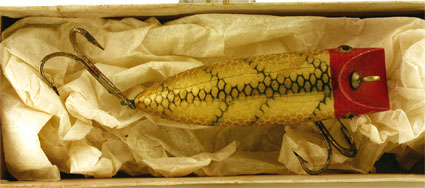
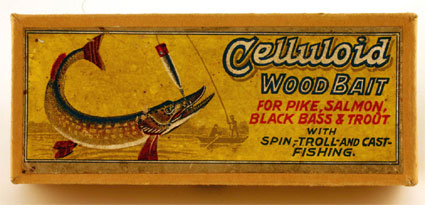
The Pinguin bait with celluloid box.
I will skip the fourth bait and look at the fifth bait model 3110. This looks like an exact copy of the Creek Chub Pikie and was called the Pikie Wobbler. It differed from the Creek Chub model in that the two sizes sold did not match any that the American company made, they were 31⁄2 and 43⁄8 inches long.
The colours offered were Blue and Silver, Yellow and Gold Scale, Brown and Gold, Green and Brown, White- Red and Silver, and Green and Black (Pike Scale).
The bait had the Creek Chub patented lip, double line tie and glass eyes. It did not reappear after 1939.
The sixth bait was a copy of the Heddon Vamp model 7500 which was available in the same colours as the Pikie Wobbler. This bait was called the Zyklop (Cyclops in English) Wobbler model 5290. It was introduced in 1936 and like the Heddon model, it had a deep diving vane with a hook tie under the chin. It was not listed after 1939.
The fourth bait illustrated in the 1936 catalogue was model 3030 Piguin (Penguin in English) Wobbler. Sold in four sizes 1 1⁄4, 1 3⁄4, 2 1⁄4 and 3 1⁄2 inches and looks to be a copy of the South Bend Bass Oreno. The catalogue states that the shape of the lure was a well-established pattern with a zigzag motion.
Only one size compared exactly with the South Bends lure and I believe that these baits were manufactured by DAM with no need to seek approval from the American company.
They were available in seven colours White and Red, White Red and Silver, Yellow and Orange, Yellow and Red Spotted, Green and Gold, Yellow with Red Spots and Dark ribs, and Luminous for night fishing.
This particular bait was the one that led me to draw certain conclusions regarding a few mysteries that needed clearing up. I would ask you to bear with me while I explain the detective trail.


Two section Wobbler in a Celluloid box.
The Celluloid Wood Bait shown has the Pinguin Wobbler in it. If we look at the other boxed Celluloid bait we see a two-section Wobbler.
Look at the Pike on the box top of the Celluloid bait and then look at the Pike on the box top of the Ever Ready bait. Same artist?
We then take it a little further and we see another Celluloid boxed bait from the collection of Ron Handley. Placed alongside this we see a Goble boxed bait and it is the same bait as the Celluloid one.
Look at the two-section bait, again this has the Creek Chub diving lip and two line attachment points. What makes this bait different from others is that it has a carved tail.
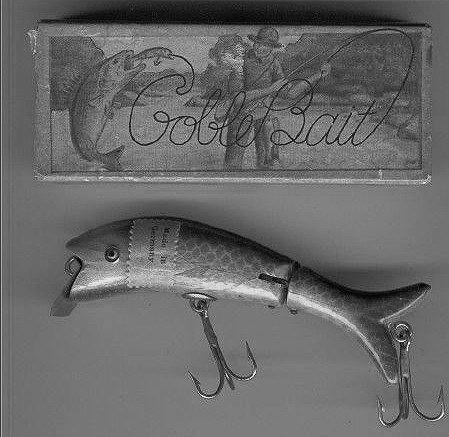
Two section bait in Goble box with MADE IN GERMANY sticker.
Look also at the picture of the Goble bait sold on eBay last year. We can see a sticker MADE IN GERMANY. What’s going on?
Well, the Goble bait company of Tulsa Oklahoma took out US patent 1,487,556 in 1922 for a two-section bait. As far as I am aware this bait has never been found. Either it proved to be too expensive to make or it did not work. What the company
need was as bait to sell.
Bert Goble did import baits and he went to DAM for his source. We will return to this subject in a future issue.
Stefan Duma
January 2004.

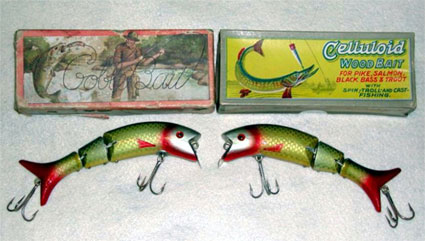
Creek Chub lip detail on two section Celluloid Wobbler.
A pair of Tulsa Wobblers from the collection of Ron Handley in Goble and Celluloid boxes.
The last article certainly did cause some interest and I want to thank all those people who were kind enough to supply information.
Various information came to light and here we will just tie up all the loose ends.
Walt Hickerson from Tulsa is a collector who specialises in Goble baits and was kind enough to get me a copy of the paperwork that came with a bait. This piece of paper belongs to Louie Tate who acquired it from a guy called Kent Clarke also known as Superman by some.
He found it at a garage sale in the early 1970’s. It was in a boxed set of Goble baits all mint and unused, he left the baits and bought the paper for $1. No one has ever seen the boxed set of baits or knows what happened to them.
As you can see the bait was called the Tulsa Wiggler and B. G Goble had a few thousand of the baits made. He intended to start making the baits in his factory along with his patent minnow. The thoughts are that he never got the factory running and went back to his oil field supply company.
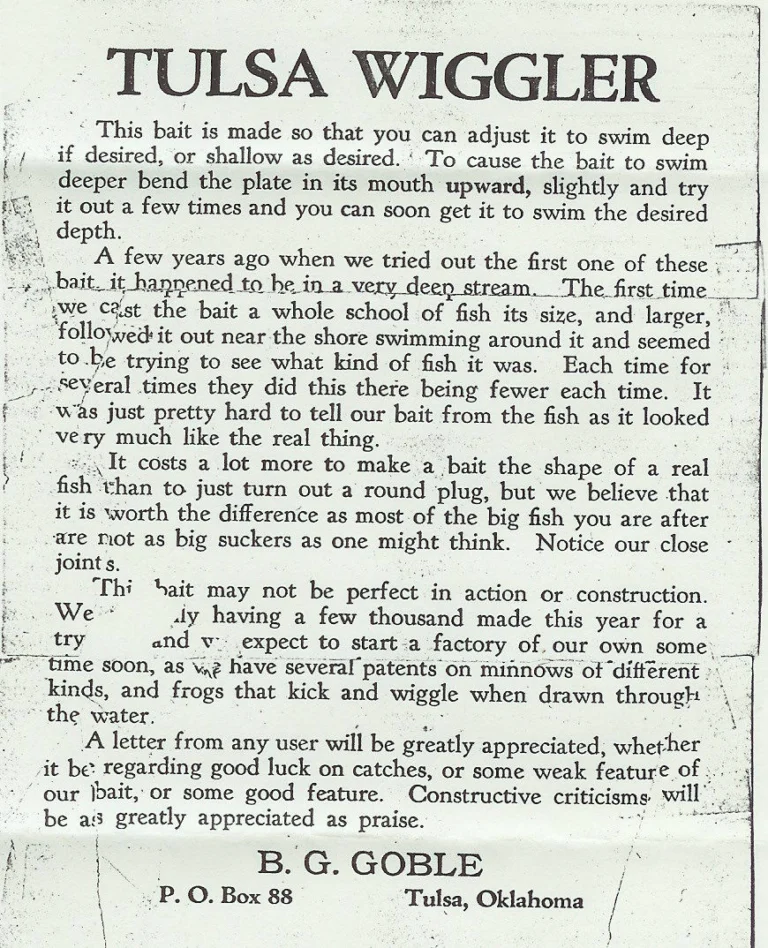
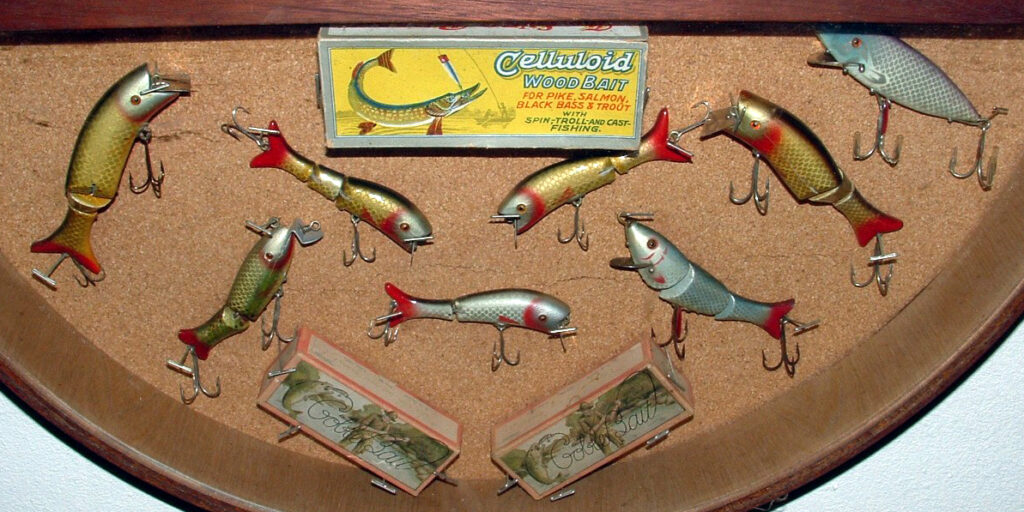
Walt Hickson’s collection of Gobel baits.
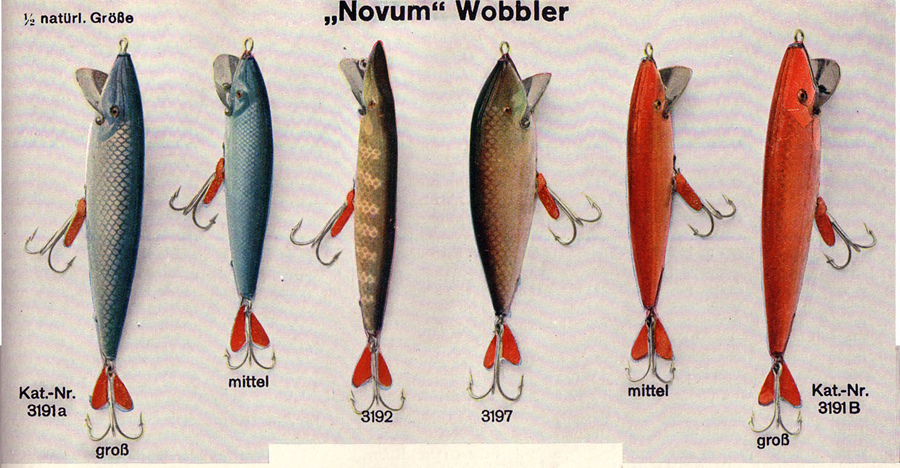

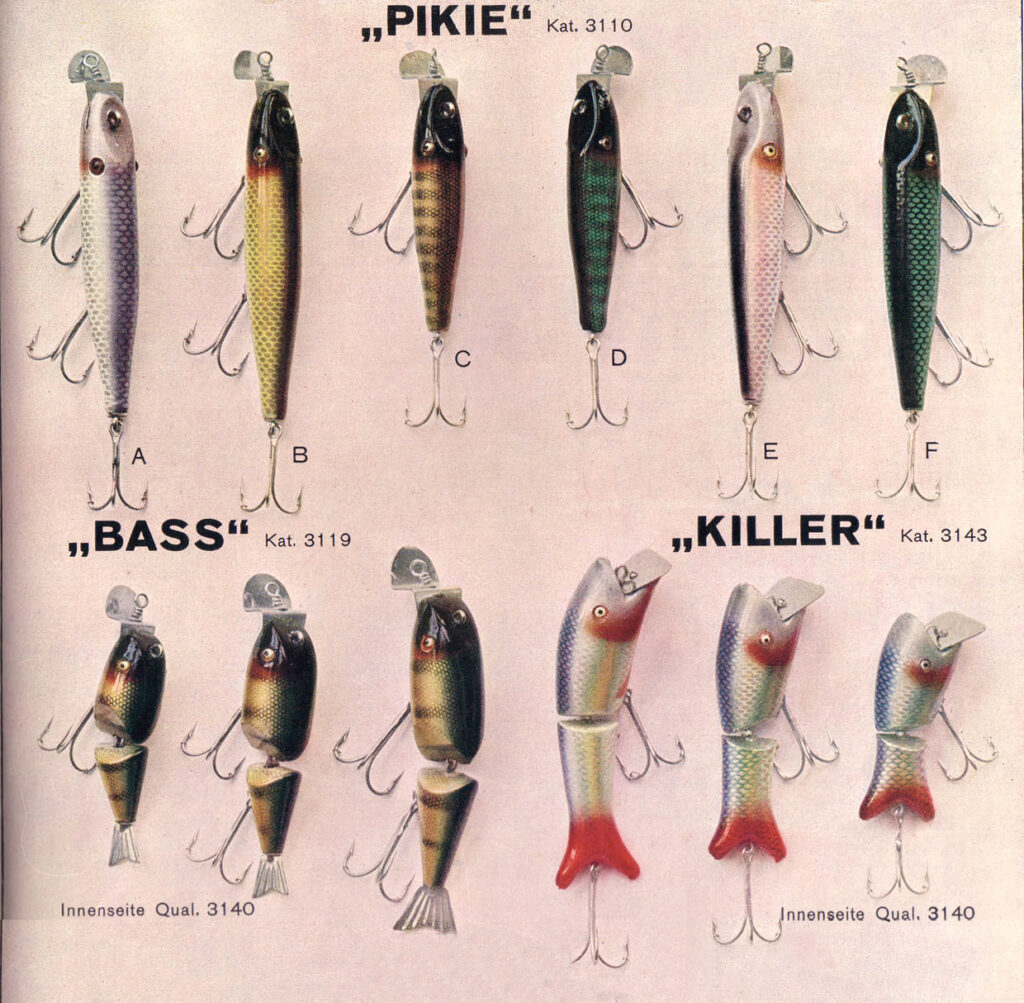
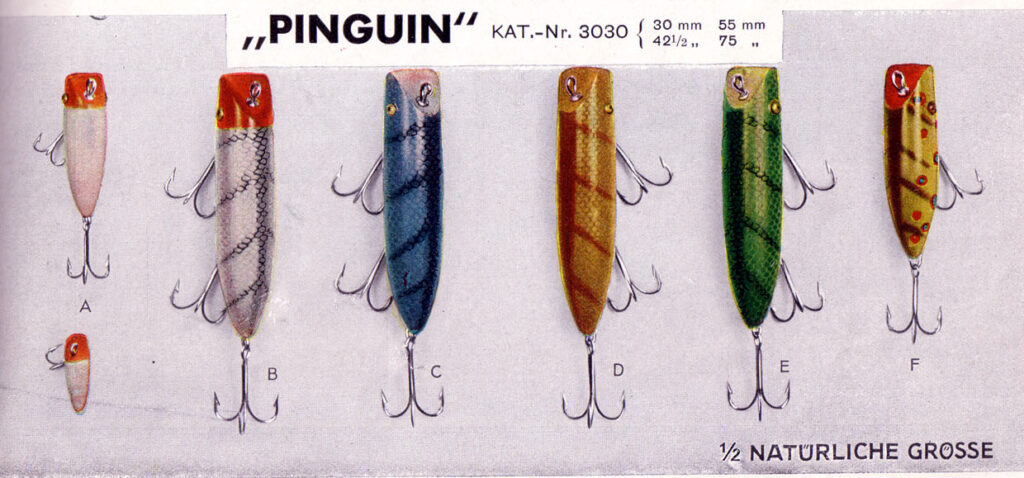
Illustrations from the DAM 1933 catalogue showing their own made baits.
Access to a DAM catalogue circa 1933 finally cleared up the mystery of who made the Vampir baits. The original DAM Vampire baits were made by Heddon and imported into Germany by them.
Heddon had patented and introduced them as the Gamefisher in 1923 but it was not until the early 1930’s that DAM started to import them into Europe. DAM quickly introduced them to Europe, copied them, came out with an improved bait and considerably expanded the range of baits offered. This expansion came in the early 1930s after Otto Kuntze had perfected the making of the baits.
Otto Kuntze had originally joined DAM in 1910 providing additional resources to Oscar and Fritz Ziegenspeck the founders of the company.
His improvement was in the coating that was applied to the basic Heddon bait.
The German language catalogue calls the bait the D.A.M Wobbler (Holz=Zelluloid=Spinner) which translates as “Wooden Celluloid Spinner”.
We also see the American retailed DAM bait, the Celluloid Wooden bait, and I have been asked were some made of celluloid. The answer is no. What DAM had done was to cover the bait with a celluloid finish rather than the standard wood varnish. With the help of some very experienced chemists, he came up with his new covering. I suspect that it was similar to the celluloid used by Percy Wadham. After all, DAM did retail the Wadham baits in various European countries.
They also made slight adjustments to the positioning of the treble hooks to give a better-performing lure with
greater durability.
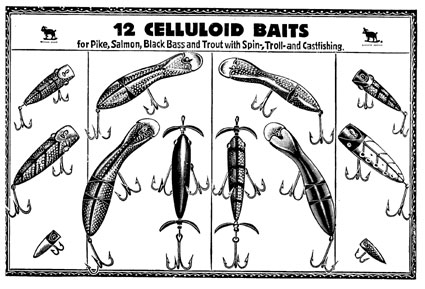
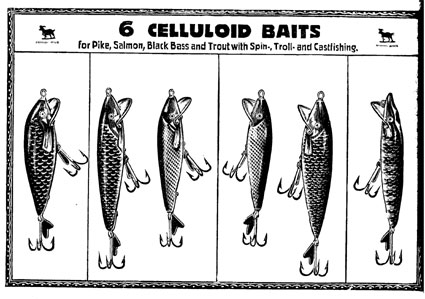
Twelve box and six box samples of Celluloid baits
DAM claimed to be a European maker of such baits and the only ones who claimed to make these baits were selling DAM-made baits.
One picture that I omitted from the last article is the one showing the similarity of artwork on the Ever Ready box and the Celluloid box.
I have also included the illustrations from the 1933 DAM catalogue.
To sum up:
The first Vampir baits were made by Heddon and imported into Germany.
In 1933 Otto Kuntze had perfected his version of this bait and sold it through his European distribution network.
DAM imported the Wigglefish from Creek Chub and then made their bait in three different sizes unlike the single-size Creek Chub Wigglefish. These baits were called Bass.
The Celluloid Baits were made by DAM for export to Europe and the USA. These baits were the Oreno, Killer, Pinguin, Bass
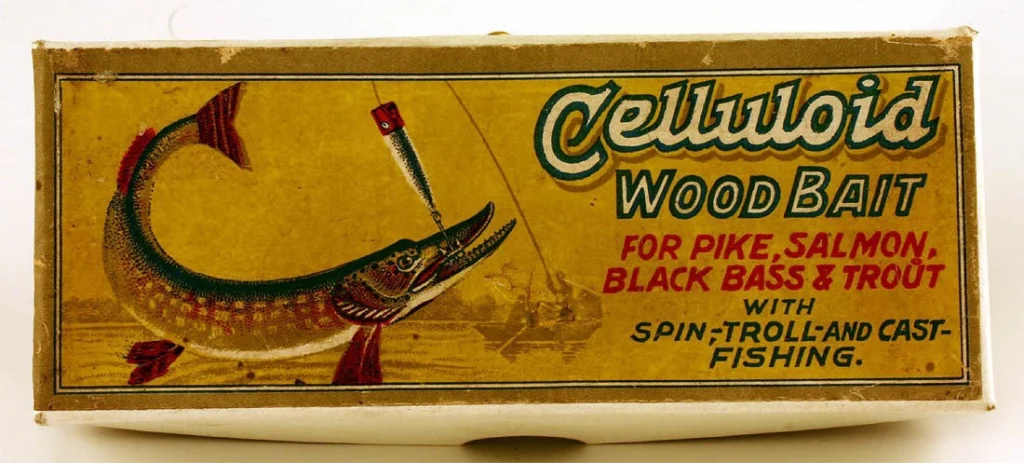
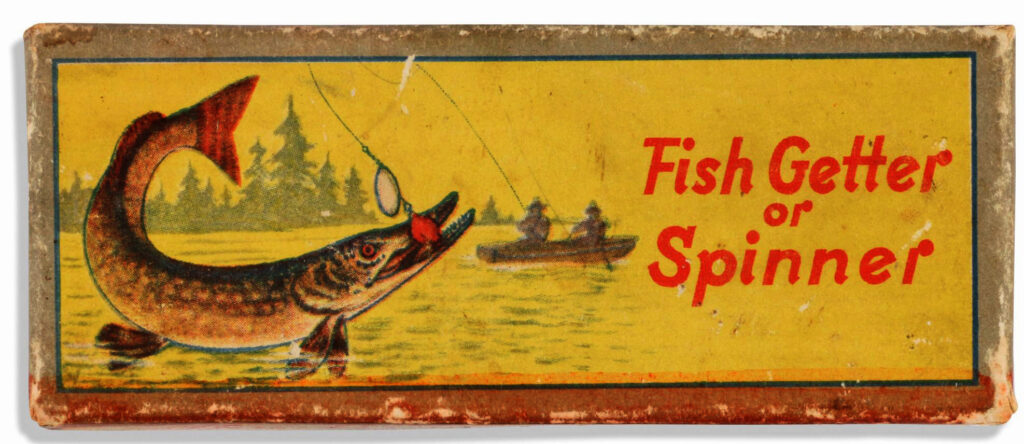
Celluloid and Ever Ready box.
DAM made baits for Gobble who sold and marketed them in the USA. These baits were the two and three-section Tulsa Wiggler that DAM sold through their distribution network as Killers.
All the companies were aware of each other’s products with cooperation taking place initially between them. I suspect that after a while the American companies thought that as the DAM company offered no real threat they just let them get on with it.
Clyde Harbin sent me a series of photographs of baits that he had located in the Heddon factory some years ago. Interestingly, the Wigglefish is almost certainly a DAM-manufactured bait.
He also saw various Heddon Game Fishers and Vampir baits again from the Heddon factory. Why would they have them? Almost certainly checking up on what DAM was producing and keeping informed about what was going on in the world.
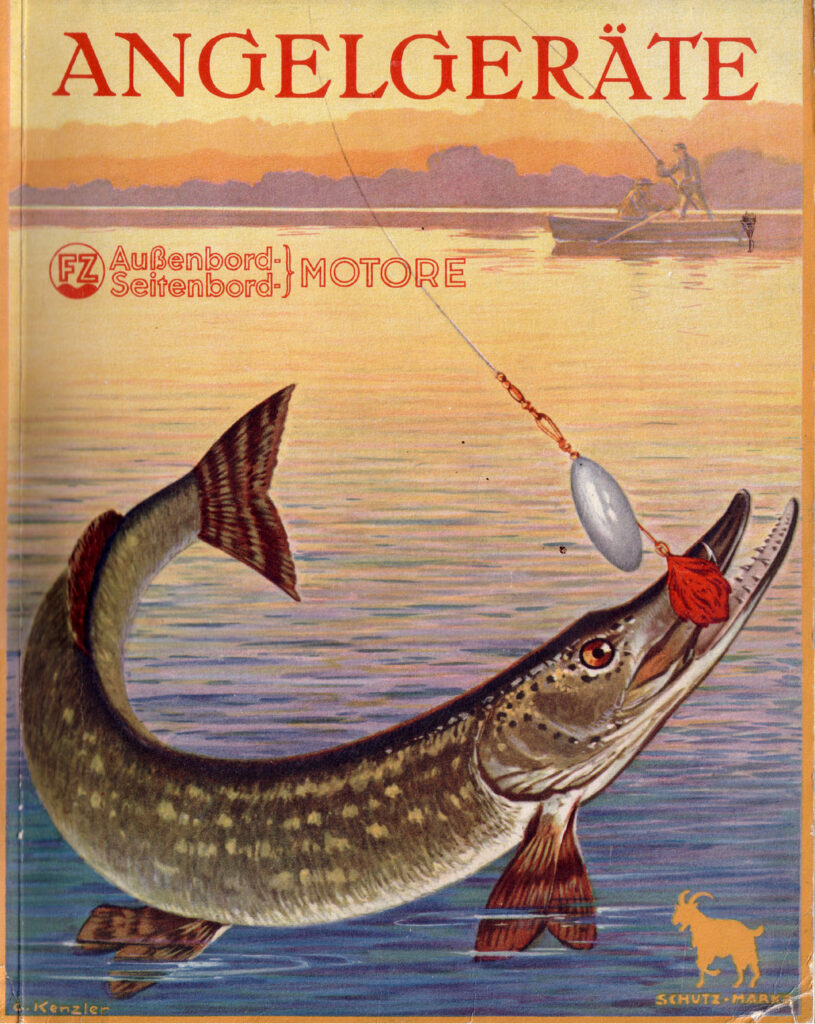
1936 DAM catalogue, all illustraions look like the same artist.